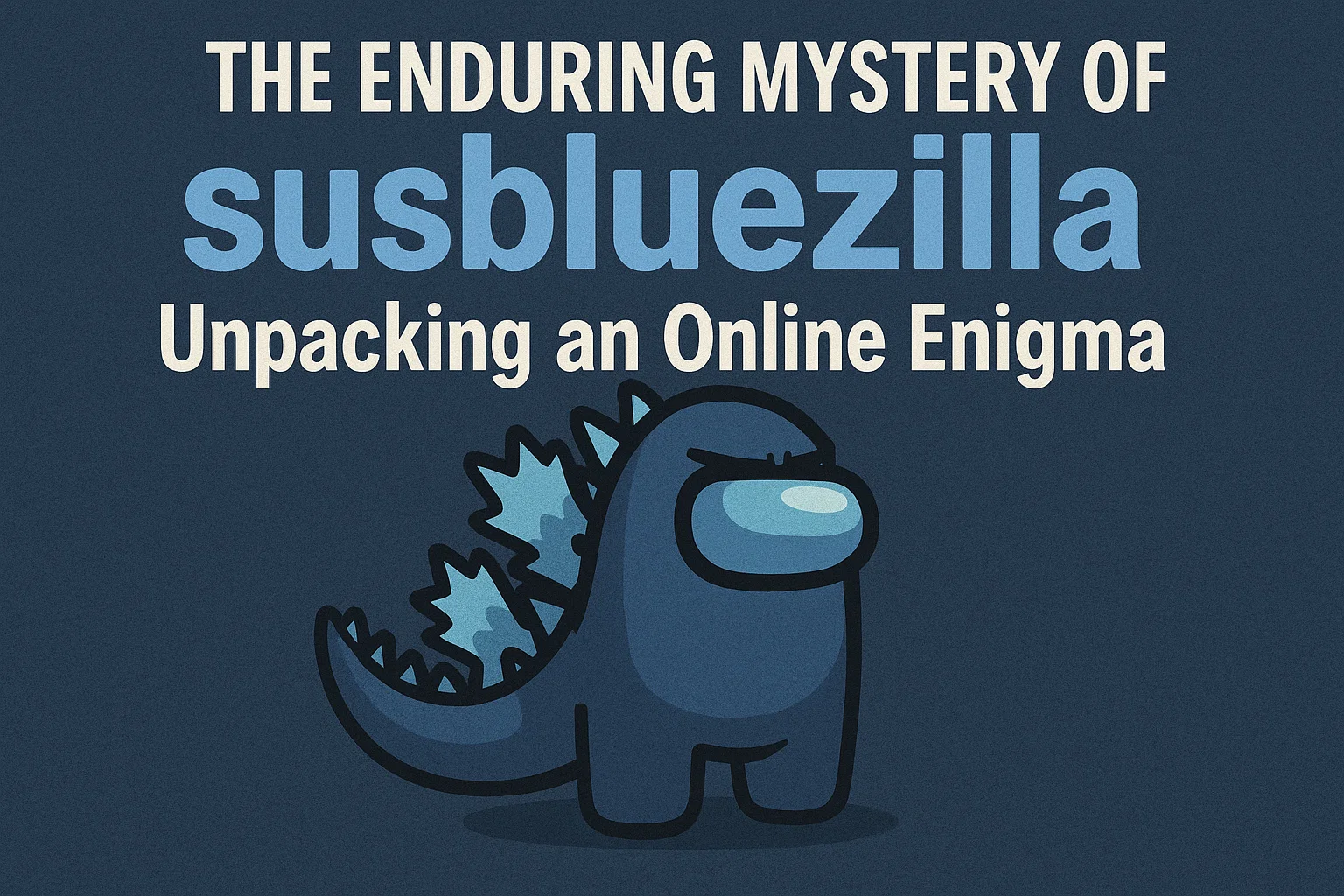In the vast, ever-shifting landscape of internet culture, certain phenomena emerge from the digital ether to capture collective curiosity. These aren’t always grand corporate announcements or viral memes in the traditional sense. Sometimes, they are whispers, glitches in the matrix, or usernames that appear at just the right time to spark imagination. One such phenomenon is susbluezilla. To the uninitiated, it might look like a random string of characters or a typo. But to those who have encountered it scattered across forums, game chats, and social media platforms, susbluezilla represents something more: a modern digital mystery, a blank canvas for projection, and a testament to how online communities forge their own mythology. This article is a deep dive into the heart of this enigma. We’ll explore its potential origins, its cultural resonance, and why a simple phrase like susbluezilla can become a focal point for discussion, speculation, and connection in the boundless digital realm.
The story of susbluezilla isn’t found in official press releases or verified news articles. It’s written in the fragmented, user-generated content that forms the bedrock of web culture. It exists in the comments sections of YouTube videos, the dedicated threads on Reddit and obscure forums, and the fleeting messages of in-game chats. Understanding susbluezilla is less about finding a single truth and more about appreciating the journey of the search itself. It’s a puzzle that invites participation, encouraging anyone who sees it to ask, “What does this mean?” and, more importantly, “What can I make it mean?” This process of collective sense-making is a defining feature of how modern internet folklore is born and sustained.
The Origins and Etymology of susbluezilla
Where did it all begin? Pinpointing the exact genesis of susbluezilla is like trying to find the source of a river after it has already branched into a massive delta. The digital footprint is widespread, but the original spark remains elusive. This very elusiveness is a key ingredient in its mystery. Most accounts suggest that susbluezilla first began popping up in online gaming environments, particularly within massively multiplayer online games (MMOs) or competitive team-based shooters where player interaction is constant and often anonymous. The name itself appears to be a portmanteau, a blend of two distinct words: “sus” and “bluezilla.”
The word “sus” exploded into mainstream popularity thanks to the game Among Us, where it is shorthand for “suspicious.” It denotes someone who is acting strangely or who might be the impostor. However, its usage predates the game in internet slang, rooted in a more general sense of something being off or not quite right. “Bluezilla” is a more complex element. It could be a simple combination of “blue” and “Godzilla,” perhaps referring to a blue-colored, monstrous, or overwhelmingly powerful entity within a game, like a rare boss character or a high-level player’s avatar. Therefore, a literal interpretation of susbluezilla might be “a suspicious blue monster” or “a suspect Bluezilla character.” This literal meaning, however, is almost certainly just the surface of a much deeper cultural artifact.
Another theory posits that susbluezilla was never meant to be meaningful. It could have originated as a randomly generated username suggested by a game’s system. A player might have seen it, found it amusingly bizarre, and adopted it. From there, others saw the name in their lobbies, leading to screenshots and questions. Alternatively, it might have started as a simple typo or autocorrect error from another phrase that somehow caught on. The lack of a confirmed origin story is not a weakness; it is the entire foundation of the legend. It allows every community and individual to craft their own narrative about what susbluezilla is and where it came from, making the phenomenon personally engaging and endlessly adaptable.
susbluezilla as a Cultural Phenomenon in Online Communities
Once the name susbluezilla began to circulate, it ceased to be just a username or a phrase and transformed into a cultural token within online communities. This transformation is a classic example of how internet culture operates. A piece of content, no matter how small or seemingly insignificant, can be adopted, remixed, and propagated by users until it takes on a life of its own. On platforms like Reddit, users might create posts asking if anyone else has seen susbluezilla in their games. These posts act as a rallying point, drawing in others who have had similar experiences and validating the existence of the phenomenon.
This shared experience builds a sense of community among strangers. The inside joke of susbluezilla creates an in-group; those who know about it are “in,” while those who don’t are out of the loop. This dynamic is a powerful social glue in digital spaces where traditional forms of community building are absent. Users bond over their shared curiosity and their collective contribution to solving the mystery. They share their own supposed sightings, create memes featuring the name, and develop elaborate running jokes. susbluezilla becomes less about the original referent and more about the shared activity of engaging with the mystery itself. It’s a collaborative project in myth-making.
The phenomenon also highlights the human desire for pattern recognition and narrative. The human brain is wired to find meaning in chaos and to create stories to explain the unknown. When faced with an ambiguous signal like susbluezilla, people naturally try to fit it into a coherent narrative. Is it a famous streamer’s alt account? A developer testing the game? A secret code for a hidden quest? These theories, whether proven true or not, generate discussion, content, and engagement. The ambiguity of susbluezilla is its fuel, powering endless forums, comment threads, and video discussions as users piece together their own understanding from the fragmented information available.
The Psychological Appeal of Internet Mysteries Like susbluezilla
Why do things like susbluezilla capture our attention so effectively? The appeal is deeply rooted in psychology. The internet, for all its vastness of information, is also a place of profound ambiguity. This creates a perfect environment for mysteries to thrive. The unknown username, the cryptic comment, the glitch that seems intentional—these elements tap into our innate curiosity and our love for a good puzzle. Engaging with a mystery like susbluezilla provides a cognitive challenge that is rewarding to solve, or at least to attempt to solve.
Furthermore, in an age of information overload and algorithmic curation, discovering an organic, user-driven mystery feels authentic. It’s not a corporate marketing campaign or a manufactured viral trend (at least, it doesn’t appear to be). It feels like a genuine piece of digital folklore, something created by and for the community. This perceived authenticity makes the pursuit of susbluezilla more appealing. Participating in it is a way to engage with the internet on a human level, connecting with others over a shared, unexplainable experience rather than simply consuming content passively. It gives users a role to play, whether as an investigator, a theorist, or a meme-sharer.
There’s also an element of escapism and play. Delving into the mystery of susbluezilla is a form of play for many. It’s a game without rules, a creative exercise where the goal is to imagine possibilities. This playful engagement is a crucial aspect of online interaction, providing a break from the more serious or mundane aspects of digital life. The mystery doesn’t have high stakes; no one’s life or livelihood depends on solving it. This low-stakes environment allows for creative and whimsical theories to flourish, making the entire experience enjoyable and stress-relieving rather than frustrating. The journey of investigating susbluezilla is the reward itself.
Cat Memes: The Internet’s Feline Phenomenon
susbluezilla and the Creation of Modern Folklore
The story of susbluezilla is a textbook case of how modern folklore is created and disseminated in the digital age. Traditionally, folklore consisted of stories, legends, and myths passed down orally through generations. Today, that process happens at lightning speed on digital platforms. A strange occurrence or phrase can be screenshot, shared, and discussed by millions within hours, evolving and mutating with each retelling. susbluezilla is a contemporary “legend,” a digital campfire story whose details change depending on who is telling it.
This new folklore often centers around the technology itself. Instead of stories about ghosts in forests, we have stories about glitches in games, mysterious users, and creepy pasta about haunted websites. susbluezilla fits neatly into this genre. It is a legend born from and about the digital environment. Its narrative is co-created by a distributed community of users, each adding their own layer to the story. One user’s sighting in one game becomes corroborating evidence for another user’s theory about a different game, weaving a complex, interconnected web of narrative that spans across the internet.
The malleability of this folklore is its greatest strength. Because there is no canonical source or definitive answer, the myth of susbluezilla can adapt to different contexts and communities. For a programming forum, susbluezilla might be interpreted as a notorious bug or a piece of legacy code. For an art community, it might inspire a series of drawings of a giant blue creature. This adaptability ensures its longevity, allowing it to remain relevant as it moves from one corner of the internet to another. It becomes a shared cultural touchstone, a piece of common knowledge within the vast and often fragmented world of online culture.
The Impact of susbluezilla on Brand and Community Perception
For game developers and platform administrators, phenomena like susbluezilla present a unique opportunity and a subtle challenge. On one hand, organic community-driven mysteries are a sign of a highly engaged and creative user base. Players who are invested enough in a game’s world to speculate about mysterious usernames are demonstrating a deep level of attachment. This kind of engagement is invaluable and cannot be manufactured by any marketing team. A mystery like susbluezilla generates free publicity and keeps players talking about the game even when they are not playing it.
Some astute developers have been known to lean into these community myths. While there is no public confirmation that susbluezilla is a developer-led initiative, it’s a common tactic in the industry. Developers might create Easter eggs or introduce cryptic elements into a game to spark exactly this kind of discussion. It fosters a sense of a living, breathing world full of secrets waiting to be discovered. If a developer were to officially acknowledge susbluezilla in some way—perhaps by adding a character or an item referencing it—it would be a powerful way to reward the community’s investment and show that they are listening.
The challenge, however, lies in balancing engagement with clarity. If a mystery is perceived as a game-breaking bug or a malicious user, it can cause unnecessary concern. Most of the time, however, harmless mysteries like susbluezilla are a net positive. They strengthen the community’s bond and create a rich, player-driven narrative layer that enhances the official game content. They transform the game from a mere product into a platform for social interaction and collective storytelling, which is ultimately what makes online games so compelling and enduring.
How to Investigate an Internet Mystery Like susbluezilla
If you stumble upon your own susbluezilla—an unexplained username, a cryptic message, or a digital oddity—you might feel compelled to investigate. So, how does one go about digging into an internet mystery? The first and most important step is to document everything. Take screenshots, note the exact time and date, and record the platform, game server, or website where you encountered the phenomenon. This primary evidence is crucial for any serious investigation and for sharing your findings with others.
Next, turn to the community. The collective intelligence of the internet is your greatest tool. Search for the term on platforms like Reddit, Twitter (X), and dedicated forums. Use specific search operators on Google to narrow down results to particular sites or time periods. For example, searching "susbluezilla" site:reddit.com will show you all discussions about it on Reddit. Engage with existing threads, share your own experience, and ask questions. You might find that others have already made significant progress in unraveling the mystery, or your new piece of evidence could be the missing link someone else was looking for.
However, it’s vital to maintain a healthy dose of skepticism and digital literacy during your investigation. The internet is also a place of misinformation and hoaxes. Not every theory you read will be credible. Cross-reference information from multiple sources and be wary of claims that seem too outlandish without solid evidence. Remember that the goal is not always to find a single, definitive answer. Often, the true value of investigating a mystery like susbluezilla is the process itself: the thrill of the hunt, the connections you make with fellow investigators, and the skills you develop in critical thinking and online research.
The Future of susbluezilla and Digital Legends
What does the future hold for susbluezilla? Like many internet phenomena, its longevity will depend on the continued engagement of the community. It could fade into obscurity, remembered only as a niche inside joke from a specific period. Alternatively, it could evolve, taking on new meanings as it is discovered by new audiences. Perhaps a popular content creator will feature it in a video, catapulting it to a new level of fame and inspiring a fresh wave of investigation and speculation.
The nature of digital legends is cyclical. They often experience periods of intense activity followed by quiet dormancy, only to be rediscovered and revitalized years later by a new generation of users. The story of susbluezilla is stored on servers and archives, waiting to be found again. Its simple, quirky name gives it a timeless quality that can easily be inserted into new contexts and new games. As long as there are online spaces where users can interact and share stories, there will be potential for new mysteries like susbluezilla to emerge and capture our collective imagination.
The tools for creating and sharing these legends will also continue to evolve. With the rise of virtual reality, augmented reality, and more immersive online worlds, the potential for even more convincing and engaging mysteries will grow. Imagine encountering a holographic susbluezilla in a shared AR space or finding a data log referencing it on a derelict spaceship in a VR game. The core human desire for mystery and story will remain constant, but the mediums through which we experience them will become increasingly sophisticated, ensuring that the tradition of digital folklore continues to thrive.
Comparison of susbluezilla to Other Internet Mysteries
| Feature | susbluezilla | Cicada 3301 | The Max Headroom Incident | Local58 TV |
|---|---|---|---|---|
| Nature | Organic, community-driven username/glitch | Deliberate, sophisticated puzzle/recruitment effort | Guerrilla broadcast signal intrusion | Creepypasta analog horror series |
| Origin | Unknown, likely emergent from game chats | Intentional, created by anonymous group | Unknown hijacker(s) | Creatively intentional (Kris Straub) |
| Platform | Games, forums, social media | Internet forums, hidden websites, cryptography | Television broadcast | YouTube, social media |
| Solution | No definitive solution, open to interpretation | Complex puzzles solved by a few, purpose unknown | Never officially solved | Narrative unfolds through video content |
| Community Role | Co-creators of the myth, theorists | Solvers, competitors, followers | Spectators, investigators | Audience, interpreters |
| Authenticity | Perceived as organic and authentic | Debate over whether it’s an ARG or real recruitment | Authentic illegal act | Authentic as a work of fiction |
Quotes on the Phenomenon
“Internet mysteries like susbluezilla are the campfire stories of the digital generation. They don’t need to be solved to be valuable; their power lies in the community they build and the curiosity they ignite.” – Dr. Elena Torres, Digital Culture Researcher.
“In an algorithmically curated world, stumbling upon a genuine, user-driven enigma like susbluezilla feels like finding a secret door in a familiar room. It’s a reminder that the human element of surprise and mystery still thrives online.” – Mark Chen, Journalist and Author.
Conclusion
The enigma of susbluezilla is far more significant than the sum of its letters. It is a perfect microcosm of how internet culture operates: organic, collaborative, and endlessly creative. It demonstrates how a simple, unexplained signal can be transformed by a community into a shared narrative, a inside joke, and a piece of modern folklore. While we may never know if susbluezilla was a random username, a developer’s Easter egg, or a collective hallucination, the search for meaning itself has provided value to those who participated. It has fostered connection, sparked curiosity, and offered a playful escape. Ultimately, susbluezilla is a testament to the human need for story and mystery, proving that even in the most advanced digital landscapes, we are still drawn to the glow of a campfire and a good, unsolved tale.
Frequently Asked Questions (FAQs)
What is susbluezilla most commonly believed to be?
The most common belief is that susbluezilla originated as a randomly generated username within an online game that gained notoriety due to its odd and memorable nature. Players encountering this name in their lobbies began screenshotting it and sharing it online, sparking questions and theories. This led to its spread across various platforms as a community in-joke and a subject of lighthearted speculation, with no single, verified explanation ever solidifying.
Is there any evidence that susbluezilla is a hacker or a bot?
There is no credible public evidence to suggest that susbluezilla is associated with malicious activity like hacking or is a bot. The phenomenon lacks the hallmarks of such operations, which typically leave more obvious digital footprints or have a clear goal. The behavior attributed to susbluezilla is more consistent with an organic community meme or a player whose username simply caught on due to its peculiarity, rather than any coordinated technical threat.
How can I report a sighting of susbluezilla?
If you believe you’ve encountered susbluezilla, the best way to “report” it is not to any official authority but to the community of investigators and enthusiasts. You can do this by taking a screenshot or screen recording that includes the username and the context (e.g., the game name, server, and time). Then, share your finding on relevant subreddits, gaming forums, or social media platforms using the hashtag #susbluezilla. This contributes to the collective tracking of the phenomenon.
Could susbluezilla be an ARG (Alternate Reality Game)?
While it’s a compelling theory, it’s highly unlikely. Alternate Reality Games are typically characterized by a much higher degree of coordination, narrative planning, and puzzle design guiding players from one clue to the next. The susbluezilla phenomenon appears far more fragmented and emergent, lacking the central narrative or progressive complexity of a designed ARG. It remains a bottom-up community myth rather than a top-down orchestrated game.
Why has susbluezilla become so popular?
susbluezilla has gained popularity because it perfectly taps into several key aspects of internet culture: the love of mystery, the joy of community inside jokes, and the appeal of low-stakes investigation. Its ambiguous nature invites participation—anyone can have a theory or share a sighting. Furthermore, its simple and catchy name makes it easy to remember and share, allowing it to spread quickly through screenshots and conversations, building a sense of shared experience among disparate internet users.




